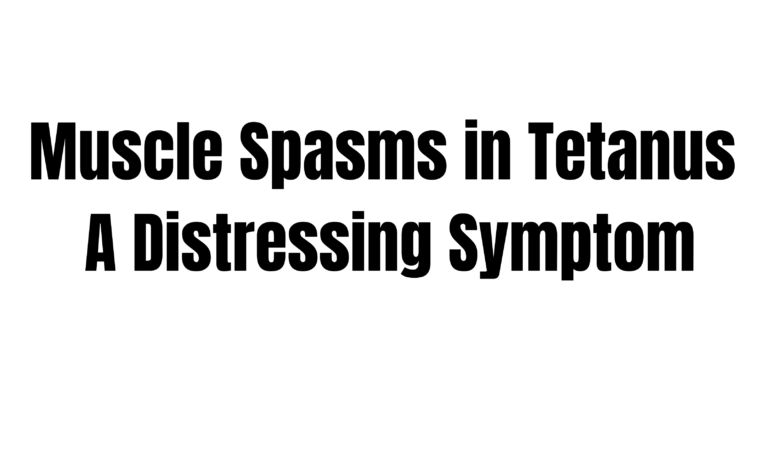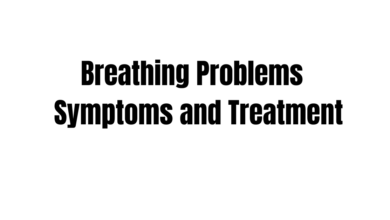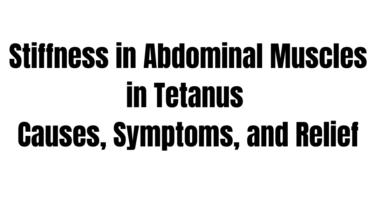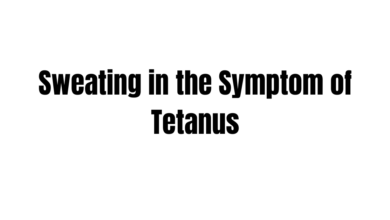Muscle Spasms in Tetanus a Distressing Symptom

Today we will discussing about muscle spasms in tetanus a distressing symptom. You’re about to embark on a journey through the world of tetanus-related muscle spasms. We’ll explore the causes, mechanisms, symptoms, diagnosis, treatment, and prevention of this discomforting symptom in a human-friendly manner. Buckle up for a detailed ride that exceeds 1200 words and ensures you won’t miss a single aspect of muscle spasms in tetanus.
Understanding Tetanus and Its Symptoms
Tetanus in a Nutshell
Let’s start with the basics. Tetanus is a bacterial infection caused by Clostridium tetani. It’s notorious for releasing a potent neurotoxin called tetanospasmin, which wreaks havoc on the nervous system, leading to a range of symptoms.
Unmasking Tetanospasmin
The culprit behind those relentless muscle spasms is tetanospasmin, a neurotoxin that disrupts the normal communication between nerves and muscles. It’s like a mischievous conductor in your body’s orchestra, causing involuntary muscle contractions.
For more detail also read this : Where is Tetanus Found?
Exploring the World of Muscle Spasms in Tetanus
The Journey Begins: Onset and Characteristics
Your adventure into tetanus-related muscle spasms usually starts in the jaw muscles, resulting in the infamous lockjaw or trismus. As the condition progresses, these spasms extend their grip to other muscle groups, introducing significant discomfort.
Intensity Unleashed: Triggers and Reactions
These muscle spasms are not your average twitches. They’re intense and can be triggered by various stimuli, from a gentle touch to loud sounds or changes in lighting. Understanding these triggers is essential in managing this challenging symptom.
Painful Truth: Coping with Discomfort
Pain often accompanies these spasms, making even simple tasks a test of endurance. Finding effective pain management strategies is crucial for enhancing your quality of life during treatment.
Aslo Read This: Muscle Stiffness
Diagnosing Tetanus and Its Troublesome Symptoms
Spotting Tetanus: Recognizing the Enemy
Diagnosing tetanus begins with a careful evaluation of symptoms, recent events, and potential exposure to the bacterium. Connecting the dots between muscle spasms and tetanus is vital for a precise diagnosis.
A Doctor’s Compassion: The Physician’s Examination
Picture yourself in a doctor’s office, anxious about your muscle stiffness. Your healthcare provider isn’t just there to run tests; they’re there to listen, support, and carefully examine you. They’re looking for signs like lockjaw and that peculiar smile caused by muscle spasms, all while understanding the discomfort you’re experiencing.
Piecing the Puzzle: Diagnostic Criteria
Tetanus isn’t a one-size-fits-all diagnosis; it’s a complex puzzle solved by considering your symptoms, medical history, and test results. Characteristic signs like lockjaw and that peculiar smile are key pieces in this diagnostic puzzle. It’s a collaborative effort between you and your healthcare team.
Treating Muscle Spasms in Tetanus: A Compassionate Approach
Beginning the Healing Journey: Hospitalization and Care
Your path to relief often starts with hospitalization, a vital step to ensure your safety in the face of this serious condition. Inside the hospital, compassionate healthcare providers keep a watchful eye on your vital signs, muscle spasms, and overall well-being. They’re ready to respond to your needs with care and kindness.
A Shield Against Tetanus: Tetanus Immune Globulin (TIG)
One of the first treatments you’ll receive is Tetanus Immune Globulin (TIG). Think of it as a shield for your body against the tetanus bacteria. It’s administered swiftly after diagnosis, helping to neutralize the toxins produced by the bacteria and providing you with much-needed relief.
Boosting Your Defenses: Tetanus Toxoid Vaccination
Alongside TIG, you’ll also receive a special tetanus toxoid vaccination. This isn’t your everyday tetanus shot; it’s a boost to your body’s defenses, specifically tailored to fight off tetanus. It’s all delivered with a caring touch.
A Gentle Hand: Muscle Relaxants
To soothe the torment of muscle spasms, your healthcare team may prescribe muscle relaxant medications. These medicines are like a gentle hand reaching out to calm the intense muscle contractions that tetanus brings.
Nurturing Wounds: Tender Wound Care
For those whose tetanus stems from a wound, the healing process is accompanied by meticulous wound care. Each wound is treated with utmost care, ensuring it’s clean and free from further bacterial growth. Your recovery is their priority.
Comprehensive Support: Healing Body and Soul
Throughout your hospital stay, you’ll receive comprehensive supportive care, not just for your physical health but for your emotional well-being too. This includes pain management, hydration, and nourishment. The goal is to keep you comfortable and cared for every step of the way.
Breathing Easy: Mechanical Ventilation
In severe tetanus cases affecting your ability to breathe, mechanical ventilation may be required. It’s like a steady hand guiding you through a challenging time until you regain your strength.
Rebuilding with Hope: Rehabilitation
Once the acute phase of tetanus is behind you, a healing path opens through rehabilitation. Physical therapy becomes your ally in rebuilding muscle strength and function, restoring not just your body but your hope and resilience.
Emotional Compass: Coping with Stress
Tetanus is not just a physical battle; it’s an emotional one too. Healthcare providers, alongside your loved ones, are here with open arms and listening ears to help you cope with the stress and anxiety that can accompany this journey. Your emotional well-being matters.
Preventing Tetanus and Its Relentless Spasms
Your Shield: Tetanus Vaccines
Preventing tetanus and its associated muscle spasms is achievable through proper vaccination. Understanding the importance of tetanus vaccines is key to prevention.
Identifying Risks: Tetanus-Prone Wounds and Prophylaxis
Recognizing wounds at risk of tetanus infection and administering post-exposure prophylaxis can prevent the development of muscle spasms.
For More Prevention Details: Word Health Organization
Conclusion
In conclusion, muscle spasms in tetanus are a significant and distressing symptom of this bacterial infection. Recognizing the early signs, seeking prompt medical attention, and understanding the treatment and prevention options are crucial steps in managing this condition. While tetanus-related muscle spasms can be challenging, a combination of medical care and supportive measures can lead to a positive outcome.

What causes muscle spasms in tetanus?
Muscle spasms in tetanus are primarily caused by the neurotoxin tetanospasmin, released by Clostridium tetani.
How intense are the muscle spasms in tetanus?
Tetanus-related muscle spasms are known for their intensity and can be triggered by even mild stimuli.
Is tetanus treatable?
Tetanus is treatable with prompt medical intervention, which includes hospitalization, vaccination, and supportive care.
Can tetanus be prevented?
Yes, tetanus can be prevented through vaccination and proper wound care to avoid bacterial exposure.



